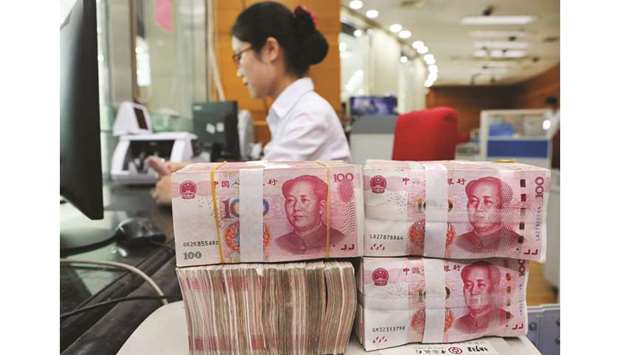China, having let the yuan cross the once sacred red line of 7 per dollar, will allow its currency to fall further and may even risk US anger by using it as a bargaining chip in already thorny trade talks, market participants believe.
Beijing had kept the yuan on the strong side of 7 since 2008, so effectively abandoning that trading floor on August 5 triggered intense investor activity.
The currency’s 3.8% decline in August as a whole was its sharpest monthly fall in 25 years, prompting US President Donald Trump to launch a fresh salvo in the more-than 15-month tariff war by labelling China a currency manipulator.
While the central bank (PBoC) denies that charge, its attempts this month to smooth the yuan’s weakening suggest the currency’s fluctuations are not entirely unsupervised. But in contrast to past episodes of depreciation, sources within policy circles – as well as financial analysts – do not expect Beijing to hem in the yuan in a defined range this time.
“It is unlikely that policymakers will impose a level on themselves, having got the psychological seven out of the way,” said Frances Cheung, Asia strategist at Westpac Banking Corp in Singapore.
“It took some effort to (do that)... while avoiding any big capital outflows and market swings, so it would be unwise to self-impose another level.”
Cheung expects the currency to end 2019 at 7.3.
That would be 2% lower than current levels – the onshore yuan finished Thursday’s domestic trading at a three-week low of 7.1315 per dollar – and down 6.4% since June. Yuan non-deliverable forwards price it at 7.15 in six months and 7.19 in a year, suggesting many other market participants, while still expecting a fall, are not so confident in the PBoC’s willingness to unshackle the currency. “Some people have predicted that the yuan may depreciate to 7.2-7.3 if the Sino-US trade war worsens, we cannot rule out that possibility,” said Yu Yongding, a former policy adviser to the People’s Bank of China (PBoC).
“But one thing is certain: There won’t be any sharp depreciation.” Another source familiar with the PBoC’s thinking said it was more difficult for the authorities to intervene in an increasingly market-driven currency. “Over the medium- and long term, once the 7 level is broken, nobody believes 7.1 or 7.2 will be the bottom, but the chance of breaking 7.3 is small,” he said.
The most bearish yuan forecasts are premised on the trade war dragging on into 2020 and taking an even bigger toll on China’s exports and investments.
If not for that damage, China’s still healthy trade surpluses and the force of massive foreign capital inflows into mainland stock and bond markets argue for the yuan to be strengthening. But the spectre of devaluation was enough to spook markets.
For a currency long tightly policed via a daily mid-point fixing and a trading band, the break through 7 was seen as much a pressure release as a reminder the PBoC could wield the yuan to insulate Chinese exporters from rising US tariffs.
The weakening reflected economic fundamentals, but also served to warn the US that further depreciation was possible, said Cliff Tan, head of global markets research for East Asia in Hong Kong. “Look at it as a bit of a defensive parry in the bilateral trade negotiation.” Beijing has been at lengths to insist the yuan isn’t a tariff war weapon and turning it into one would destabilise China’s economy, arguing that the break below 7 was a reaction to the rising trade tensions with Washington.

An employee counts 100-yuan notes at a bank in Nantong in China’s eastern Jiangsu province. China, having let the yuan cross the once sacred red line of 7 per dollar, will allow its currency to fall further and may even risk US anger by using it as a bargaining chip in already thorny trade talks, market participants believe.

